rhythm -
A visual tempo or beat. The principle
of design that refers to a regular repetition of elements
of art to produce the look and feel of movement.
It is often achieved through the careful placement of repeated
components which invite the viewer's eye to jump rapidly or glide
smoothly from one to the next.
In any artwork, it is possible to distinguish between rhythm of color, line, and form. In the continuity of the three comes the whole rhythm of that work.
Rhythm unites the visual culture with music, but in visual culture, rhythm is more evident in the applied arts than in the fine arts. In the former, it is often the foremost means of aesthetic expression.
Rhythm originated in the Greek word rhymthmos, meaning measured flow, which they passed into Latin as rhythmus, meaning movement in time. Its first uses in English were literary, in reference to themetrical rhyming of verses. English speakers began to use rhythm concerning repetition of musical beats in the late 18th century, and about visual elements in the same period.
Each artist, every period, every culture produces a characteristic sort of rhythm. Recognizing a work's rhythmical peculiarities often aids in identify the culture or time in which it was produced, if not the individual artist who produced it.
Rhythm's importance can be demonstrated by noting how many important rhythmic cycles we observe in nature — consider the alternating tension and relaxation in the heart's beating or in the ocean's waves, the revolutions of the earth around the sun, the comings and goings of generations. Each of us has personal rhythms to our days, weeks, and years. Life, indeed, would be chaotic without rhythm. Participating in the tempo of this flow gives us excitement and calm, yearning and contentment, yin and yang. It is natural that we would employ rhythms to organize and unify our works, much as they do the rest of our experience.
There are several types of visual
rhythm. These include:
regular rhythms - The background design behind this text has a regular rhythm. (In the following examples, let the letters A, B, etc. stand for visual elements of any sort)
AB-AB-AB is the most common type. Picture alternating stripes of two colors, for instance. (In English prosody, a student of poetry might read this as either "iambs" or "trochees". An iamb is a metrical foot consisting of two syllables, the first syllable accented, the second accented, as in AB-AB-AB. It becomes trochaic meter if the accenting is reversed, as in AB-AB-AB.)
Some more examples:
ABC-ABC-ABC (In English prosody, a student of poetry might read this as "anapests" or "dactyls". An anapest is a metrical foot consisting of three syllables, the first two syllables unaccented, the third accented, as in ABC-DEF-GHI-JKL. A dactyl consists of three syllables, the first accented, the second and third unaccented, as in ABC-DEF-GHI-JKL.)
ABBB-ABBB-ABBB
ABCB-ABCB-ABCB
ABCDCDA-ABCDCDA-ABCDCDA
alternating rhythms -
some examples:
ABA-CDC-ABA-EFE-ABA-CDC-ABA-EFE-
ABC-ABC-ABC-DEF-DEF-DEF-ABC-ABC-ABC-DEF-DEF-DEF-
ABCD-DCCBBA-ABCD-DCCBBA
progressive rhythms - Progression occurs when there is a gradual increase or decrease in the size, number, color, or some other quality of the elements repeated.
some examples:
AB-AABB-AAABBB-AAAABBBB
AB-AB-AB-AB-AB-AB
AB-AB-AB-AB-AB-AB-
ABC-ABD-ABE-ABF-ABG-ABH-ABI
flowing rhythms -
random rhythms -
Each of these types of rhythm might be altered periodically. Music theory might be defined as the study of rhythms and their periodic alterations.
Example of works displaying rhythm:
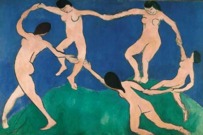
Henri Matisse (French, 1869-1954), Dance (first version), 1909, oil
on canvas, 8 feet 6 1/2
inches x 12 feet 9 1/2 inches (259.7 x 390.1 cm), Museum of
 Modern
Art, NY.
Modern
Art, NY.
Matisse painted a second version of Dance in 1910, oil
on canvas, 102 x 154 inches
(260 x 391 cm), Hermitage Museum, St. Petersburg, Russia.
Dance, together with Music, was commissioned by S.I.Shchukin to decorate the staircase in his Moscow mansion. Matisse took the motif of the round dance, used as a symbol back as far as French Renaissance, to represent the rhythm and expression of the 20th century. The spaciousness and expressive lines emphasize the dynamics of the figures. Simplified and schematic forms intensify the brightness and resonance of the three colors — red, blue and green. See music. Dance, Matisse once said, meant "life and rhythm." See dance, music, and movement.
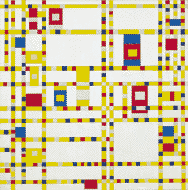
Piet Mondrian (Dutch, 1872-1944), Broadway Boogie Woogie. 1942-43, oil on canvas,
50 x 50 inches (127 x 127 cm), at the Museum of Modern Art, New
York. See De
Stijl and grid.

Paul Klee (Swiss, 1879-1940), Rhythmisches (In Rhythm), 1930, oil on woven jute, 69.6 x 50.5 cm, Georges Pompidou Center, Paris. See Bauhaus and Swiss art.
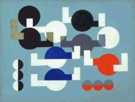
Sophie Taeuber-Arp (Swiss, 1889-1943; to France 1928), Composition of Circles and Overlapping Angles (Composition à cercles et à bras superposés), 1930, oil on canvas, 19 1/2 x 25 1/4 inches (49.5 x 64.1 cm), Museum of Modern Art, NY. See feminism and feminist art.
![]()
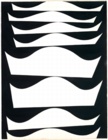
Sophie Taeuber-Arp, Echelonnement désaxé, 1934, gouache on paper, 13 7/8 X 10 5/8 inches (35.1 X 27 cm), Museum of Modern Art, NY.
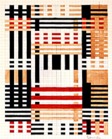
Anni Albers (born Analise Fleischman, married Josef Albers) (German, 1899-1994), Design for Wall Hanging, 1926, gouache and pencil on paper, 14 x 11 1/2 inches (35.6 x 29.2 cm), Museum of Modern Art, NY. See Bauhaus and textile.
"Rhythm and harmony find their way into the inward places of the soul."
Plato (427?-327? BCE), Greek philosopher. The Republic, Book III, 401d, as translated by B. Jowett, 1901. See harmony.
Also see animation, arrangement, chronology, cinema, composition, dance, direction, egg-and-dart, eurythmy, four-dimensional, harmonic sequence, harmony, kinetic, juxtaposition, measure, metamorphosis, mobile, movement, obsession, pattern, periodicity, music, sequence, space-time, time, and whirligig.
https://inform.quest/_art